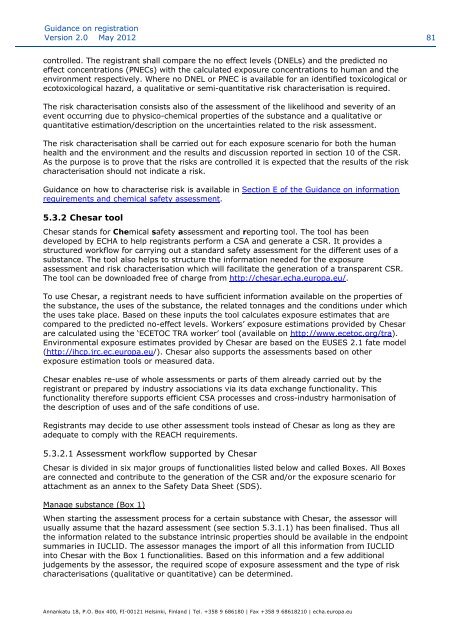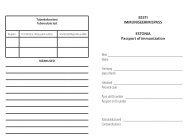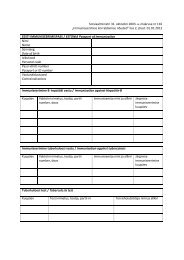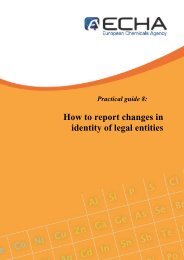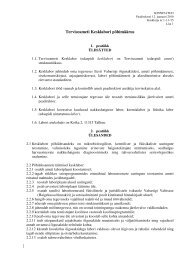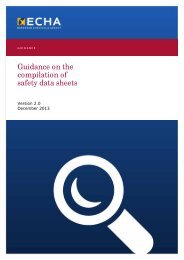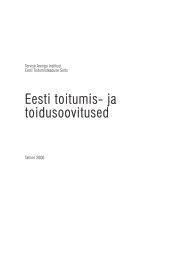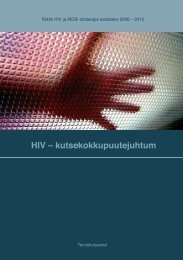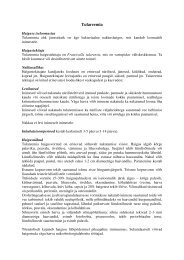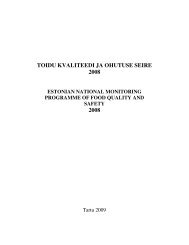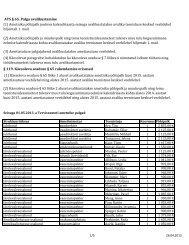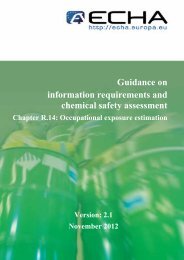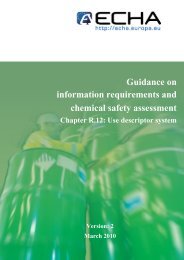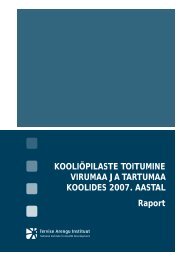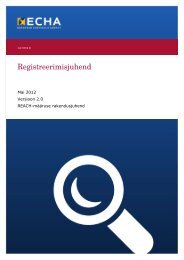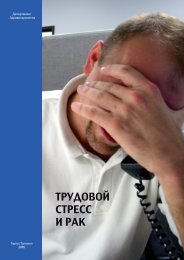Guidance on registration - ECHA - Europa
Guidance on registration - ECHA - Europa
Guidance on registration - ECHA - Europa
You also want an ePaper? Increase the reach of your titles
YUMPU automatically turns print PDFs into web optimized ePapers that Google loves.
<str<strong>on</strong>g>Guidance</str<strong>on</strong>g> <strong>on</strong> registrati<strong>on</strong><br />
Versi<strong>on</strong> 2.0 May 2012 81<br />
c<strong>on</strong>trolled. The registrant shall compare the no effect levels (DNELs) and the predicted no<br />
effect c<strong>on</strong>centrati<strong>on</strong>s (PNECs) with the calculated exposure c<strong>on</strong>centrati<strong>on</strong>s to human and the<br />
envir<strong>on</strong>ment respectively. Where no DNEL or PNEC is available for an identified toxicological or<br />
ecotoxicological hazard, a qualitative or semi-quantitative risk characterisati<strong>on</strong> is required.<br />
The risk characterisati<strong>on</strong> c<strong>on</strong>sists also of the assessment of the likelihood and severity of an<br />
event occurring due to physico-chemical properties of the substance and a qualitative or<br />
quantitative estimati<strong>on</strong>/descripti<strong>on</strong> <strong>on</strong> the uncertainties related to the risk assessment.<br />
The risk characterisati<strong>on</strong> shall be carried out for each exposure scenario for both the human<br />
health and the envir<strong>on</strong>ment and the results and discussi<strong>on</strong> reported in secti<strong>on</strong> 10 of the CSR.<br />
As the purpose is to prove that the risks are c<strong>on</strong>trolled it is expected that the results of the risk<br />
characterisati<strong>on</strong> should not indicate a risk.<br />
<str<strong>on</strong>g>Guidance</str<strong>on</strong>g> <strong>on</strong> how to characterise risk is available in Secti<strong>on</strong> E of the <str<strong>on</strong>g>Guidance</str<strong>on</strong>g> <strong>on</strong> informati<strong>on</strong><br />
requirements and chemical safety assessment.<br />
5.3.2 Chesar tool<br />
Chesar stands for Chemical safety assessment and reporting tool. The tool has been<br />
developed by <strong>ECHA</strong> to help registrants perform a CSA and generate a CSR. It provides a<br />
structured workflow for carrying out a standard safety assessment for the different uses of a<br />
substance. The tool also helps to structure the informati<strong>on</strong> needed for the exposure<br />
assessment and risk characterisati<strong>on</strong> which will facilitate the generati<strong>on</strong> of a transparent CSR.<br />
The tool can be downloaded free of charge from http://chesar.echa.europa.eu/.<br />
To use Chesar, a registrant needs to have sufficient informati<strong>on</strong> available <strong>on</strong> the properties of<br />
the substance, the uses of the substance, the related t<strong>on</strong>nages and the c<strong>on</strong>diti<strong>on</strong>s under which<br />
the uses take place. Based <strong>on</strong> these inputs the tool calculates exposure estimates that are<br />
compared to the predicted no-effect levels. Workers’ exposure estimati<strong>on</strong>s provided by Chesar<br />
are calculated using the ‘ECETOC TRA worker’ tool (available <strong>on</strong> http://www.ecetoc.org/tra).<br />
Envir<strong>on</strong>mental exposure estimates provided by Chesar are based <strong>on</strong> the EUSES 2.1 fate model<br />
(http://ihcp.jrc.ec.europa.eu/). Chesar also supports the assessments based <strong>on</strong> other<br />
exposure estimati<strong>on</strong> tools or measured data.<br />
Chesar enables re-use of whole assessments or parts of them already carried out by the<br />
registrant or prepared by industry associati<strong>on</strong>s via its data exchange functi<strong>on</strong>ality. This<br />
functi<strong>on</strong>ality therefore supports efficient CSA processes and cross-industry harm<strong>on</strong>isati<strong>on</strong> of<br />
the descripti<strong>on</strong> of uses and of the safe c<strong>on</strong>diti<strong>on</strong>s of use.<br />
Registrants may decide to use other assessment tools instead of Chesar as l<strong>on</strong>g as they are<br />
adequate to comply with the REACH requirements.<br />
5.3.2.1 Assessment workflow supported by Chesar<br />
Chesar is divided in six major groups of functi<strong>on</strong>alities listed below and called Boxes. All Boxes<br />
are c<strong>on</strong>nected and c<strong>on</strong>tribute to the generati<strong>on</strong> of the CSR and/or the exposure scenario for<br />
attachment as an annex to the Safety Data Sheet (SDS).<br />
Manage substance (Box 1)<br />
When starting the assessment process for a certain substance with Chesar, the assessor will<br />
usually assume that the hazard assessment (see secti<strong>on</strong> 5.3.1.1) has been finalised. Thus all<br />
the informati<strong>on</strong> related to the substance intrinsic properties should be available in the endpoint<br />
summaries in IUCLID. The assessor manages the import of all this informati<strong>on</strong> from IUCLID<br />
into Chesar with the Box 1 functi<strong>on</strong>alities. Based <strong>on</strong> this informati<strong>on</strong> and a few additi<strong>on</strong>al<br />
judgements by the assessor, the required scope of exposure assessment and the type of risk<br />
characterisati<strong>on</strong>s (qualitative or quantitative) can be determined.<br />
Annankatu 18, P.O. Box 400, FI-00121 Helsinki, Finland | Tel. +358 9 686180 | Fax +358 9 68618210 | echa.europa.eu


